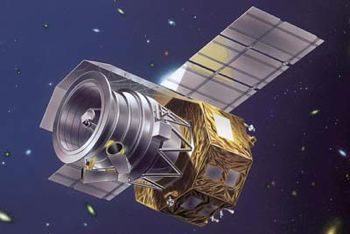
Home - Search - Browse - Alphabetic Index: 0- 1- 2- 3- 4- 5- 6- 7- 8- 9
A- B- C- D- E- F- G- H- I- J- K- L- M- N- O- P- Q- R- S- T- U- V- W- X- Y- Z
IRIS Interface Region Imaging Spectrograph
FURTHER INFORMATION ON THIS TOPIC AT OUR PARTNER SITE
 IRIS Credit: Manufacturer Image |
AKA: IRIS. Status: Operational 2013. First Launch: 2013-06-28. Last Launch: 2013-06-28. Number: 1 . Gross mass: 200 kg (440 lb). Apogee: 663 km (411 mi).
NASA NSSDC Master Catalog Description
The Interface Region Imaging Spectrograph (IRIS) is a NASA Small Explorer class solar mission. It was launched from a Pegasus XL flying out of Vandenberg AFB in California. The rocket was deployed from an Orbital L-1101 carrier aircraft flying over the Pacific Ocean at an altitude of 39,000 feet (about 12 km), roughly 100 miles northwest of Vandenberg. The rocket was dropped at 7:27 p.m. PDT on 27 June 2013 (02:27 UT, 28 June).
IRIS is intended to advance Sun-Earth connection studies by tracing the flow of energy and plasma into the corona and heliosphere for which no suitable observations exist. To achieve this IRIS will obtain high-resolution UV spectra and images of the sun's chromosphere, specifically on the non-thermal energy that creates the corona and the solar wind.
IRIS seeks to determine: (1) the types of non-thermal energy which dominate in the chromosphere and beyond; (2) the means by which the chromosphere regulates mass and energy supply to the corona and heliosphere; and, (3) how magnetic flux and matter rise through the lower solar atmosphere, and the role played by flux emergence in flares and mass ejections. To answer these questions, IRIS will utilize a single intrument, a multi-channel imaging spectrograph. See the experiment description for details on the IRIS instrument.
More at: IRIS Interface Region Imaging Spectrograph.
Family: Astronomy. Country: USA. Launch Vehicles: Pegasus, Pegasus XL.
2013 June 28 - . 02:27 GMT - . Launch Site: Vandenberg. Launch Platform: L-1011. LV Family: Pegasus. Launch Vehicle: Pegasus XL.
- IRIS - .
Mass: 200 kg (440 lb). Nation: USA.
Class: Astronomy.
Type: Solar satellite. Spacecraft: IRIS Interface Region Imaging Spectrograph.
USAF Sat Cat: 39197 . COSPAR: 2013-033A. Apogee: 663 km (411 mi). Perigee: 622 km (386 mi). Inclination: 97.90 deg. Period: 97.56 min.
NASA Small Explorer program; the IRIS Interface Region Imaging Spectrograph was designed to obtain high resolution (0.3 arcseconds) high cadence (1 second intervals) imaging and spectra of the sun with its 20-cm telescope, in two far-UV bands (1332-1358A, 1380-1406A) and one near-UV band (2785-2835A). Air dropped in Point Mugu Drop Zone.
Back to top of page
Home - Search - Browse - Alphabetic Index: 0- 1- 2- 3- 4- 5- 6- 7- 8- 9
A- B- C- D- E- F- G- H- I- J- K- L- M- N- O- P- Q- R- S- T- U- V- W- X- Y- Z
© 1997-2019 Mark Wade - Contact
© / Conditions for Use